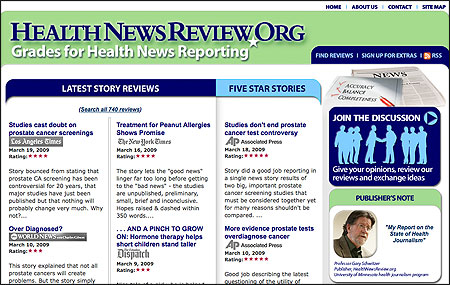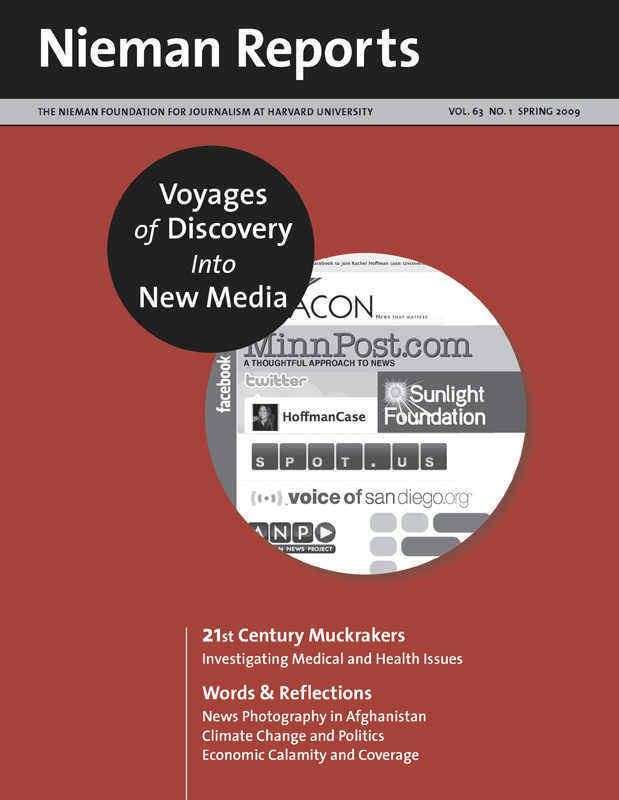
“The level of health care investigative reporting has never been better in this country even in small- and medium-sized newspapers. But the once- or twice- or three-times-a-year stories don’t make up for the daily drumbeat of stories. Health care reporting in this country is a disgrace day in and day out. The daily drumbeat is a disgrace. ‘There are no breakthroughs’—that should be the next paragraph in the story when anyone makes such a claim.”
—Don Barlett
This was the message Don Barlett, a Pulitzer Prize-winning investigative reporter, delivered to an attentive gathering at the Association of Health Care Journalists conference in 2005. Well received as his words might have been with this crowd, the “drumbeat” of news reporting of claims of breakthroughs, cures and progress in medical research and clinical care has not gone away. In fact, such reporting—notable for its lack of any investigative muscle—abounds in what is published and broadcast daily in U.S. journalism. In “Selling Sickness: How the World’s Biggest Pharmaceutical Companies Are Turning Us All Into Patients,” authors Ray Moynihan and Alan Cassels described the reporting on one such story as “sycophantic … flaccid.”
Still, some terrific in-depth health care stories, investigating key questions, do appear, though less frequently than is necessary and possible. The dissonance between what health coverage Americans receive and what they deserve is, in part, related to the direction in which those deciding on what the news is choose to go. When news reporting is seen as trumpeting new treatments, tests, products or procedures, and it is done without applying watchdog oversight, then what the news consumers get will be along the lines of what Barlett described. When reporting about health is seen, instead, as the exploration of evidence, cost-effectiveness, comparative treatments, medical technology assessment, access to medical care and disparities in care, then the news we read, see and hear will be very different.
Because I believe in the value gained when reporters take the road of exploring evidence, I’ve led a three-year effort at HealthNewsReview.org that demonstrates to journalists and the public how coverage of health care and reporting on the claims of researchers should be scrutinized. Our project is grounded in the premise that news reporting on health issues has a major influence on how the public thinks about these critical issues and, in turn, on how people regard their own well-being and treatment options.
RELATED ARTICLE
See Lieberman’s article, “As Health Care Gaps Grow, Coverage Shrinks,” from the Spring 2006 issue of Nieman Reports »Journalist Trudy Lieberman has written about the connection she sees between the work of journalists and the perception left with consumers: “What the heck, you may be asking, do journalists have to do with the soaring costs of pharmaceuticals or a $100 million device called the ‘particle accelerator’ that uses protons to bombard cancerous tumors? Journalists, after all, don’t create those products or determine their price tag. We do, though, indirectly help market them by the kinds of stories we write, which can stimulate demand. Stories touting the benefits of the latest gee-whiz drug, coupled with ads by the drug maker, are powerful stuff.”
HealthNewsReview.org is not supported by advertising; in fact, it carries none on its Web site. Its sole source of support is the Foundation for Informed Medical Decision Making, a nonprofit organization founded by Dartmouth Medical School’s Jack Wennberg and colleagues to ensure “that RELATED WEB LINK
Foundation for Informed Medical Decision Making
- www.fimdm.orgpeople understand their choices and have the information they need to make sound decisions affecting their health and well-being.” On our Web site, we have a list of independent experts who certify that they have no commercial ties to the pharmaceutical industry and have made themselves available to speak with journalists. (Others willing to do the same have made transparent their financial ties.)
Rating Stories
At HealthNewsReview.org we grade news reporting from 60 leading news organizations; we are on the lookout for those stories that include unsubstantiated claims made in the course of reporting about health. Three reviewers—all of whom must agree to forego any direct support from drug or device manufacturers—evaluate each story by applying 10 standard criteria. Each begins with the phrase “Does the story …”:
- adequately discuss costs?
- avoid disease mongering?
- evaluate the quality of the evidence?
- quantify the potential benefits?
- quantify the potential harms?
- establish the true novelty of the idea?
- establish the availability of the approach?
- use independent sources and identify conflicts of interest?
- compare the new idea with existing options?
- appear to rely on a news release?
After a story is graded, we send an e-mail to the person who wrote it and provide a direct link to our entire review. This offers reporters the opportunity to understand what they could have done to improve the quality of their reporting—and the hope is that some of this will be applied on subsequent stories.
The majority of stories we’ve reviewed reflect a kid-in-the-candy-store portrayal of the U.S. health care system. By this we mean that everything about the news is made to look promising and risk-free, and whatever the new drug or treatment or device is, it comes without any hint of a societal price tag.
RELATED WEB LINK
Read a more detailed analysis of review findings can be found in a Public Library of Science article Schwitzer wrote »On the issue of cost, journalists generally perform poorly, as they do with quantification of benefits and harms. Of the first 700 stories we reviewed, 61 to 70 percent of them failed on those three criteria. However, between 2006, our project’s first year, and 2008, it’s been uplifting for us to see that the average scores have improved on seven of the 10 criteria. To us this means that perhaps our important feedback mechanism is making some difference as reporters absorb these observations—and awareness is leading to positive change.
Screening Tests: A Particular Concern
Our review process has picked up, however, a troubling trend. In many news reports—including some done by major news organizations—a crusading advocacy seems to exist when it comes to promoting screening tests. And this happens even when such guidance conflicts with the best medical evidence. (We’ve written several articles about this topic, including one on our Web site, www.healthnewsreview.org, that offers a good summary of the evidence and our argument.) While the intent of such stories might be good, many reporters don’t seem to realize that in promoting screening tests outside the boundaries of evidence there is a good chance they cause more harm than good.
Not only does such reporting shed the journalistic pursuit of providing information that has been verified, as much as it is possible to do so, in most cases it is just plain wrong. As the saying goes, “It ain’t what people don’t know that bothers me; it’s what they know that just ain’t so.” The belief underpinning these stories is that screening of (nearly) any kind makes sense for everyone. But that “just ain’t so.” These pro-screening crusades often promote costly approaches, such as CT scans of the heart or of the lungs or of the full body, which convince many new “worried well” people to enter the health care system, costing them and all of us dearly.
If even the most rudimentary investigative effort was made with stories about screening tests—examining them along the lines posed by our 10 questions—then the information that gets out to the public via news organizations would be very different than is happening today. One thing we’ve noticed is how easy it is for journalists to become marketing arms of industry. But our experience also tells us that this doesn’t have to happen when journalism—as best practiced—remains foremost in the mind of reporters. An ounce of investigation, it turns out, can yield a pound of pride in news coverage when the story a reporter writes does not sound like an echo chamber for the industry’s message.
Gary Schwitzer, the publisher of HealthNewsReview.org, is an associate professor at the University of Minnesota School of Journalism & Mass Communication. He also writes a blog about these topics at http://blog.lib.umn.edu/schwitz/healthnews.
